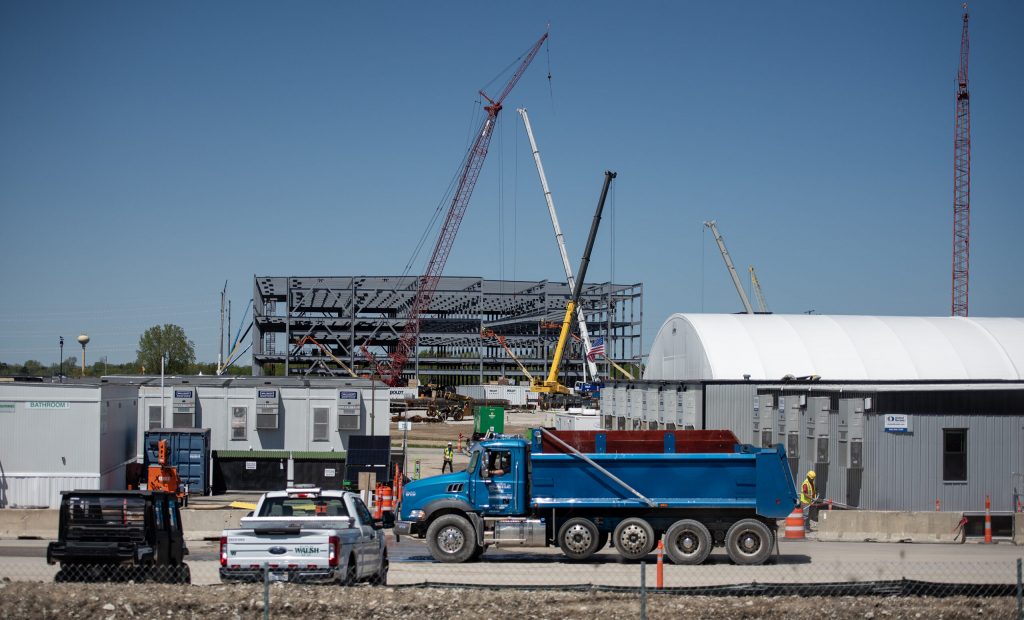Microsoft’s Wisconsin Data Center Will Rely On Diesel Backup Power
Generators expected to annually emit approximately 100 tons of nitrogen oxide.

An artificial intelligence data center is built on land once slated for development by Foxconn in Mount Pleasant on Wednesday, May 8, 2024, in Mount Pleasant, Wis. Angela Major/WPR
Microsoft will use generators that rely on diesel or renewable fuel to provide backup power at its data centers as part of the company’s $3.3 billion data center campus in Mount Pleasant.
State environmental regulators recently granted final permits to Microsoft for construction and operation of a data center, as well as changes to a data center already being built on land once slated for development by Foxconn.
As a backup power source, the generators are expected to run only for testing and emergencies and produce just under 100 tons of nitrogen oxide emissions each year. A Microsoft spokesperson said planning for disruptions to the power grid is an important focus in the design and operation of their data centers.
“Our backup power will be generated responsibly, meeting, and in some cases even exceeding, all emission controls that are applicable in this region. Based on data from our currently operating locations, we expect they will run less than 24 hours per year on average,” a company spokesperson said.
During normal operations, Microsoft’s data centers will draw power from We Energies’ system. The Milwaukee-based utility is investing nearly $2 billion in natural gas projects to meet increased demand for power, including from Microsoft. The company’s data center campus is “anticipated to become the largest electric load” served by the utility, according to a Microsoft consultant.
The company didn’t provide details on its energy usage. Data centers are known to use 10 to 50 times the energy per floor space of a typical commercial office building, prompting calls from environmental groups to power its facilities with renewable energy.

An artificial intelligence data center is built on land once slated for development by Foxconn in Mount Pleasant on Wednesday, May 8, 2024, in Mount Pleasant, Wis. Angela Major/WPR
As for backup sources, the company plans to use ultra-low sulfur diesel fuel and/or hydrotreated vegetable oil to provide power during an outage.
Hydrotreated vegetable oil, or renewable diesel, is a cleaner source of fuel made through hydrogenation of vegetable oil at a petroleum refinery. Production of renewable diesel from plant oils has increased in recent years amid wide use in transportation fuel, according to Mary Blanchard, associate director of the Wisconsin Energy Institute at the University of Wisconsin in Madison.
“It generally meets a 50 percent greenhouse gas reduction compared to petroleum-based diesel fuel,” Blanchard said, noting some companies claim even higher emissions reductions.
The DNR said changes to fuel limits for all backup generators also ensure combined emissions from the two data centers won’t be a major source of nitrogen oxide pollution. Under the permit, Microsoft’s data center could give off about 90,000 tons in equivalent carbon dioxide emissions, but the actual amount is expected to be less.
Climate, health advocates worry about worsening air quality
Even so, climate and environmental health advocates voiced concerns about the use of diesel fuel for backup power.
“That’s true that they’re not going to be running all the time, but we’re just concerned because any burning of these fuels has potential health effects,” said Claire Gervais, a family medicine physician and co-president of the Wisconsin Environmental Health Network. “If there was a brownout or blackout, burning the diesel would be more of a problem.”
Abby Novinska-Lois, executive director of Healthy Climate Wisconsin, said the DNR could have requested Microsoft explore alternative energy sources. She noted parts of Racine County, including the city of Mount Pleasant, are not meeting 2015 federal air quality standards for ozone pollution. That’s formed when nitrogen oxides react with heat and sunlight.
She added Racine County has a higher level of low-income residents who are dealing with health impacts, posing environmental justice concerns. She said the agency could have examined cumulative effects of projects on air quality in permitting.
“Or just requesting that Microsoft look into other methods for backup power generation, like batteries, which would have less of an impact on air quality,” Novinska-Lois said.
In comments, the DNR said state law doesn’t require or authorize the agency to consider cumulative impacts when acting on permits or require facilities to use “emission-free” sources in lieu of fossil fuels.
While batteries could be used, Blanchard said many don’t operate for more than four to eight hours, posing concerns if there’s an extended power outage. She said backup generators are a good option. If renewable diesel is used, Blanchard noted that it comes from a renewable source as opposed to petroleum-based diesel.
“The plant, when it was growing, was bringing in carbon from the atmosphere. Then, when it’s made into a fuel, and then is burned as a fuel, it’s just releasing that same carbon back to the atmosphere,” Blanchard said. “That’s sort of referred to as being carbon-neutral.”
“We will continue to monitor our emissions, accelerate progress while increasing our use of carbon-free energy to power datacenters, purchase renewable energy, and other efforts to meet our sustainability goals of being carbon negative, water positive and zero waste by 2030,” a company spokesperson said.
Microsoft has said diesel accounts for less than one percent of its overall emissions.
Microsoft to use diesel-fired generators as backup power for data centers was originally published by Wisconsin Public Radio.
If you think stories like this are important, become a member of Urban Milwaukee and help support real, independent journalism. Plus you get some cool added benefits.






















Someone needs to find a way to capture the the nitric oxide and convert it to fertilizer, or sell it to the makers of Cialis/Viagra!
@TosaGramps1315…that idea gets a standing ovation!